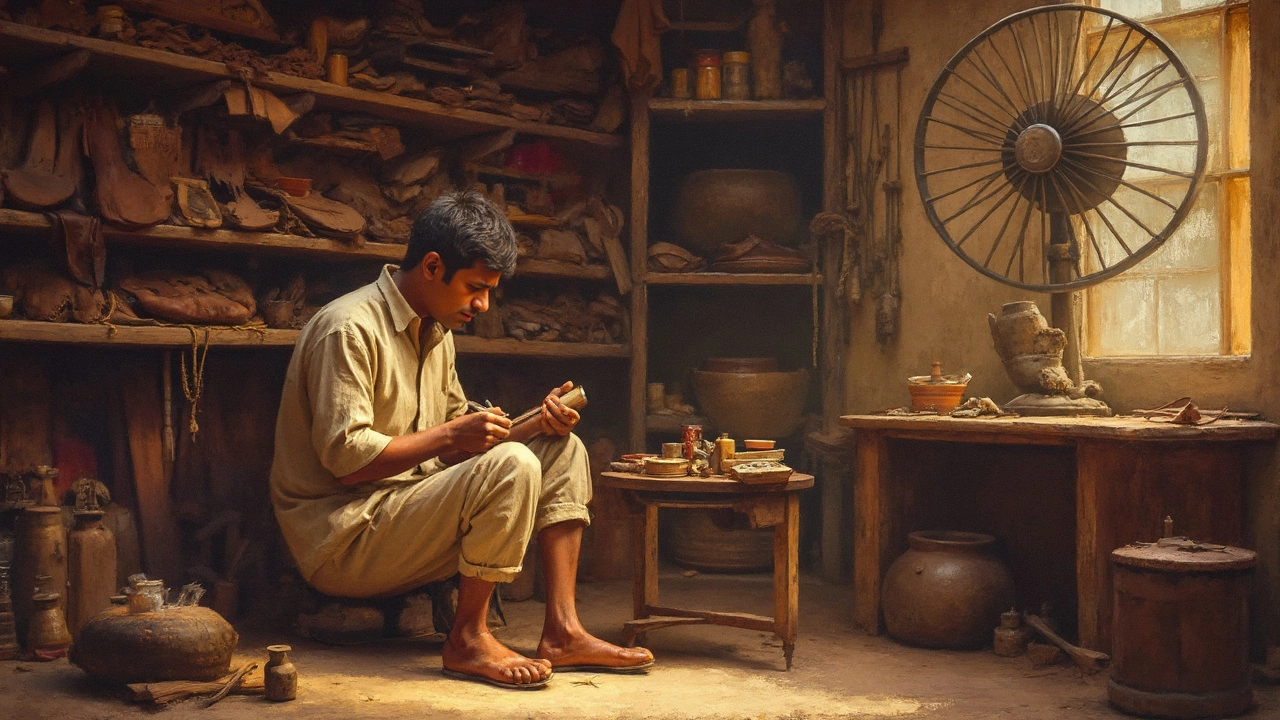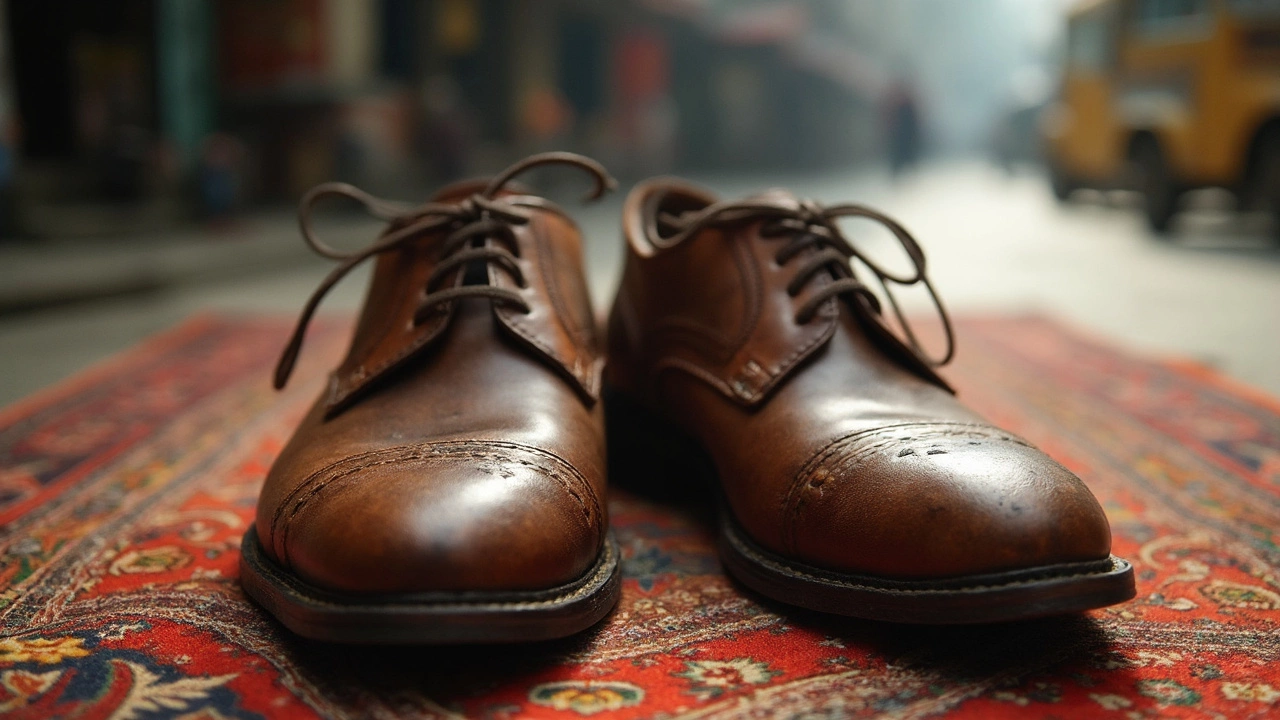We've all been there—staring at our favorite pair of leather shoes, trying to decide if they're just a little worn or officially worn out. So, when should you actually toss them? Well, let's get down to it.
First off, check those creases and cracks. Leather might add character, but deep creases and cracks usually mean the material has lost its flexibility. And loss of flexibility? That's just a fancy way of saying your shoes won't comfortably cradle your feet much longer.
Then there's the sole. If the sole is more worn than your old gym socks, it's time to rethink your relationship with those shoes. A worn sole impacts traction—and no one wants to slide across a rainy street unexpectedly, right?
Not sure if it's time? Try this: bend them back and forth. If they feel more like a rigid board than a soft shoe, think about an upgrade.
But before chucking them out, consider repairs. Sometimes a little TLC in the form of shoe polish or a trip to the cobbler can resurrect what seemed like a goner. It's a win for both your wallet and the planet.
- Signs of Shoe Wear and Tear
- Leather Life Expectancy
- Repairing vs. Replacing
- Environmental Footprint of Shoes
- Leather Shoe Maintenance Tips
- When It's Time to Say Goodbye
Signs of Shoe Wear and Tear
Your leather shoes are like a storybook, with every scuff and scratch hinting at the adventures they've been on. But how do you know when they're telling you it's time to move on? Let's break it down.
Creaks, Cracks, and Creases
Leather is a wonderful but fairly temperamental material. Over time, daily wear can lead to pesky cracks and creases. These aren't just cosmetic issues; they're the main signs that the leather is drying out and losing its suppleness. If those creases are feeling more canyon-like, it's a sign that maybe it's time they go.
Worn Soles and Heels
A telltale sign your leather shoes have seen better days is the condition of the soles and heels. Give the bottom of your shoe a glance. Seriously worn-down soles or uneven heel wear can throw off your balance and even lead to discomfort or injuries. Plus, a lack of traction might mean a slip is in your future. Dangerous!
Discomfort and Fit
Shoes should feel like a supportive handshake, offering comfort and fit. If your pair of leather shoes are now causing blisters or just generally feel uncomfortable, that's a big red flag. Shoes will soften a bit with wear, but they shouldn’t feel like a medieval torture device.
The Stinky Factor
Let's talk smell. If your shoes have developed a persistent odor, it might be due to bacteria build-up or moisture damage. No amount of foot spray will really help in the long run with extreme cases. Sometimes, they're beyond saving.
Visual Checks
A quick visual scan can also spot other wear indicators. Are the seams coming apart? Are there any major scuffs or spots of leather peeling off? If yes, you're facing an uphill battle against time and circumstances that likely won't turn in your favor.
In a nutshell, keep an eye on these signs. They're your shoe's way of letting you know when it's lived its life. Sure, they might be sentimental, but hanging on to worn-out shoes is simply not worth the hassle—trust me.
Leather Life Expectancy
So, how long do leather shoes actually last? It depends on a few factors, like quality, how often you wear them, and how well you treat them. But generally, leather shoes can last anywhere from two to five years, sometimes even longer with excellent care.
Think of leather as you would a fine wine—it generally gets better with age, but there's a limit. High-quality leather shoes are often made with better materials and craftsmanship, extending their life. Those bargain-bin finds might save you a few bucks up front but could wear out much quicker.
Factors Affecting Longevity
- Frequency of Use: Like a good pair of jeans, the more you wear them, the faster they'll wear out.
- Exposure to Elements: Rain, snow, and even the sun can take a toll on those kicks if not properly protected.
- Maintenance: Regular cleaning and conditioning are crucial. A little TLC can go a long way in extending the shoe's life.
Let's talk numbers. Studies (yes, actual studies) suggest people replace shoes roughly every 8-12 months, but leather shoes often hang in there longer because of their durability. So next time you're considering a new pair, think of it as an investment rather than just a buy.
Understanding Wear and Tear
If you notice the leather starting to crack or the shoes losing their shape, it might signal the end of their useful life. Remember, leather isn't just for looking good—it also needs to perform well, supporting your feet and stepping up to the challenges of daily life.
A survey from 2022 showed that about 60% of leather shoe owners had their shoes repaired at least once before finally discarding them. This suggests there's often room for life extension if you're willing to make the effort.
Ultimately, understanding the life expectancy of your leather shoes helps you make smarter choices about when to hold on and when to let go.
Repairing vs. Replacing
Ever wonder if it’s worth fixing up those old favorite leather shoes, or if you should just say goodbye? Choosing between repairing and replacing can be tough, but we've got you covered with some clear pointers.
Assessing the Damage
Start by checking the extent of the wear and tear. If your shoes are scuffed, have worn-out soles, or maybe have a few loose stitches, these can often be fixed. A cobbler can work some magic with new soles, polished leather, and reinforced stitching.
On the flip side, if the leather’s starting to crack or they feel less comfortable no matter what you do, it might be a sign that replacement is a smarter bet.
Cost Consideration
Let’s talk dollars. Repairing is usually cheaper than buying a new pair—especially if you’ve got a high-end brand. A new set of soles or a detailed polish can delay replacement for a fraction of the cost.
Environmental Impact
Feeling eco-friendly? Repairing keeps shoes out of landfills, reducing waste. Plus, you help cut down on the energy and resources used to produce new shoes, which is a win for Mother Earth.
What Can Be Repaired?
- Resoling: This can make old shoes feel new with added grip.
- Re-stitching: Loose seams? Stitching makes them good again.
- Polishing: A good polish can rejuvenate dull and scratched leather.
| Repair Type | Average Cost |
|---|---|
| Resoling | $30-$80 |
| Re-stitching | $10-$30 |
| Polishing | $5-$15 |
When to Replace
If repair costs start looking close to the price of new shoes, it’s time to shop around. At the end of the day, comfort reigns supreme, and if you’re throwing cash at a money pit, it might be worth heading for a replacement.
So, whether it's repair or replace, let the damage, cost, and conscience guide your call for those leather shoes.

Environmental Footprint of Shoes
Who knew that shoes could pack such a punch when it comes to the planet? You'd be surprised. Let’s break down the environmental footprint of those trusty leather shoes and why it matters.
First up, leather production. It's not the most Earth-friendly process. Tanning leather often involves loads of water and chemicals. These chemicals, if not handled right, can harm the environment. Plus, it takes about 2,110 gallons of water to produce just one pair of leather shoes! That’s enough to make anyone think twice.
Next, consider the resources. Leather is a natural material, which might sound great, but it's derived from livestock. This means your shoes contribute to the carbon footprint associated with livestock farming, which is significant. And those soles? Made of rubber or synthetic materials? Not typically biodegradable, leading to more landfill waste.
If you're the type that loves numbers, you’ll appreciate this: a Life Cycle Assessment study found that producing shoes generates around 30 pounds of CO2 per pair. That's roughly the same as leaving a light bulb on for a week without turning it off.
So, what can you do about it? Here are some steps:
- Invest in quality shoe care. Make that leather last and reduce the need for buying replacements.
- Consider brands with eco-friendly practices. Some use vegetable tanning and recycled materials.
- When done with your shoes, think about resale or repurposing before dumping them.
Being a bit mindful goes a long way. By extending the life of your leather footwear and making informed choices, you contribute to minimizing that environmental impact. After all, a little effort from each of us can lead to big change for our planet.
Leather Shoe Maintenance Tips
If you want your leather shoes to last longer than a season, treating them right is key. Here are some handy tips to keep those kicks looking sharp.
1. Keep Them Clean
Start with the basics—dust and dirt can cause leather to deteriorate. Use a soft brush or cloth to wipe away daily grime. For deeper cleaning, a specific leather cleaner will do wonders, restoring shine you thought was long gone.
2. Condition Regularly
Conditioning your leather isn't just a one-time deal. Aim to do this every few months. A good conditioner keeps the leather soft and prevents it from drying out or cracking.
3. Polish for Perfection
Polishing not only enhances color but also protects the leather from moisture. Grab a polish matching the shade of your shoe, buff it in, and you'll see instant results.
4. Use Shoe Trees
Shoe trees aren't just for fancy folks. They help maintain the shape of your shoes and absorb moisture. Wooden shoe trees are best if you want to keep the form and fend off odors.
5. Rotate Your Shoes
Wearing the same pair daily is a sure way to wear them out fast. Rotate between a few pairs to give each shoe a breather. It helps them last longer and keeps you stylishly varied.
6. Invest in Quality
When possible, choose quality leather shoes. They require less frequent replacements and usually need less maintenance. In the long run, it's worth the investment.
Bonus Tip: Waterproof Them
A waterproof spray can act as a shield against rain and unexpected puddles. Remember, even if it's a sunny day, carrying some protection is wise.
When It's Time to Say Goodbye
Parting with your favorite leather shoes can be a tough decision, but there are some tell-tale signs that indicate it’s time to let go. Keeping an eye on these can save you from a world of discomfort and even prevent some embarrassing slips or falls.
Cracking and Creasing
If your shoes are looking like they belong on some sort of fashion relic display because of extensive cracking and creasing, it's a cue they're past their prime. With deep cracks, the leather has lost its essential oils, making it brittle and prone to more damage.
Lost Shape and Structure
Leather shoes should offer support, but if they start feeling like a floppy pair of socks, they’re not doing their job. When the leather loses its shape and starts resembling more of a foot mitt than a shoe, it's time to consider an upgrade. This lack of structure can lead to foot pain, so don’t ignore it.
Worn-Out Soles
Check the bottom of your shoes. If they’re as smooth as a dance floor, you’re in trouble. No tread means no grip, making wet surfaces especially dangerous. Don't wait until you're doing an unintended moonwalk down the sidewalk to replace them.
Repair Costs v/s New Pair Costs
Sometimes it’s cheaper to just replace than repair. A good rule of thumb? If fixing your current shoes costs more than half the price of a new pair, it might be time to say goodbye. Save those dollars for something fresh and comfy instead.
| Repair Type | Average Cost (USD) |
|---|---|
| Resoling | 60-100 |
| Restitching | 25-50 |
| Full Restoration | 80-150 |
So, next time you're contemplating the fate of your cherished footwear, keep these points in mind. It might just be the nudge you need to finally treat yourself to a new pair. After all, your feet deserve the best, right?

